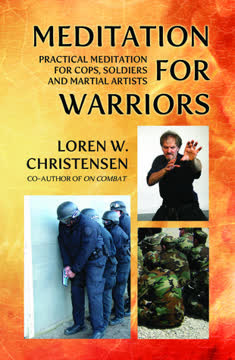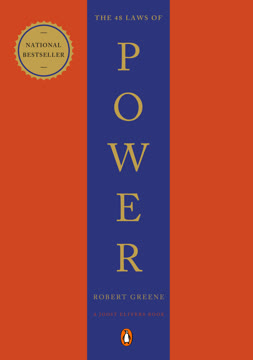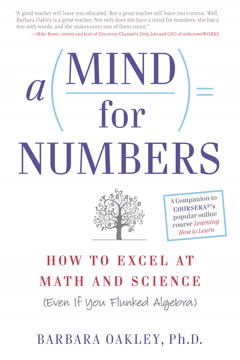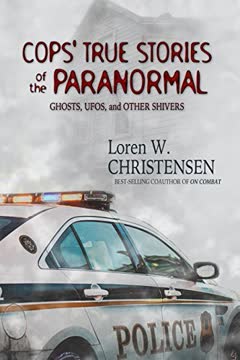Key Takeaways
1. Meditation is a Simple, Practical Tool for Warriors
The only equipment you need is—nothing.
Demystifying meditation. Forget the "woo-woo" stereotypes of gurus, incense, or New Age beliefs; meditation, at its core, is simply "doing nothing" – sitting, standing, or walking quietly. It requires no special gear or adherence to any particular religion, making it accessible to anyone, from military personnel and police officers to martial artists and everyday individuals. The author, a seasoned martial artist, war veteran, and retired street cop, emphasizes that meditation is a practical discipline that enhances performance in all aspects of a warrior's life.
Effortless practice. Unlike strenuous physical training, meditation is effortless and enjoyable, focusing on relaxation, calmness, and peace. The complexity often associated with it is unnecessary; true meditation is stripped to its essence, making it easy to integrate into a busy lifestyle. Even a quick 5-minute session, like the one taught to Marines, can initiate a sense of relaxation and mental clarity, proving its immediate utility.
Universal applicability. This practice is not confined to specific times or places; it can be done anywhere, from a quiet home corner to a bustling post office line or even the back of a police van. The benefits begin immediately, offering relief from stress and a path to mental quietness. It's a versatile tool that adapts to the warrior's environment, providing a moment of stillness amidst chaos.
2. Warriors Gain Critical Advantages from a Calm Mind
Meditation is a lot like doing reps at a gym. It strengthens your attention muscle.
Beyond "suck it up." The outdated "suck it up" mentality is giving way to a recognition of meditation's critical importance for warriors. This ancient, non-sectarian practice, embraced by top athletes and martial artists for centuries, is now gaining traction in military and law enforcement for its proven effectiveness in high-stress environments. It's a strategic tool that, like any effective weapon or tactic, has withstood the test of time because "it works."
The "empty cup" analogy. Stress and dynamic input can fill one's "cup," leading to emotional upset, panic, or irrational actions, even in seasoned professionals. Meditation, however, acts on three levels to manage this: it expands the nervous system's capacity (a bigger cup), allows for greater restfulness (draining the water), and helps avoid accumulating stress (avoiding water). This leads to profound benefits:
- Better sleep and increased energy
- Clearer focus and concentration
- Enhanced physical relaxation and stress release
- Improved anger and anxiety control
- Faster learning and better decision-making
Mental resilience. Regular meditation shifts brainwaves from draining beta states to energizing alpha and theta states, boosting memory, concentration, and overall happiness. This "aah factor" – that profound sense of peace and calm – becomes a consistent benefit, preparing the mind for high-risk tasks by providing clarity of thought and greater control over physical actions. It helps warriors remain calm and collected when "the you-know-what hits the hydro-electric powered oscillating air current distribution device."
3. Mastering the Foundational "Nuts and Bolts" of Meditation
Your mind is an instrument, a tool, [a weapon].
The "Set, Sit, and Forget" method. This foundational approach, championed by Dr. Timothy Storlie, simplifies meditation into three core steps:
- Set: Mentally establish your intention (e.g., "Sitting here makes me feel more calm, centered and relaxed."). Always keep statements positive, as the subconscious may not process negatives.
- Sit: Get comfortable, close your eyes, place your tongue on the roof of your mouth, and gently focus on your belly or heart area, breathing naturally.
- Forget: Release all distractions, to-do lists, and the urge to "try" to relax or stop thoughts. Simply breathe, gently guiding your attention back when it wanders.
The power of the trigger word. A "trigger word" is an incredibly powerful tool, acting like a start button to induce a mild sense of calm and relaxation on demand. By repeating a chosen word (e.g., "calm," "relax") while in a deeply relaxed meditative state, you program your subconscious to activate this feeling instantly. This can be used to:
- Expedite relaxation when starting meditation.
- Regain composure after interruptions or traumatic incidents.
- Bring on a mild sense of calm during chaotic moments.
Correct breathing is crucial. Proper belly breathing, where the abdomen expands on inhalation and contracts on exhalation, is fundamental to all meditation techniques. Unlike shallow chest breathing, which can lead to fuzzy thinking, anxiety, and physical pain, correct breathing revitalizes organs, increases energy, improves focus, reduces stress, and fortifies the immune system. It's a simple yet profound adjustment that enhances overall well-being and mental clarity.
4. Achieve Profound Calm with Diverse Meditation Techniques
To see a thing clearly in the mind makes it begin to take form.
Cultivating inner peace. One of the immediate benefits of consistent meditation is a profound sense of calm that permeates daily life, even amidst chaos. The author recounts how meditation transformed his nerve-wracking book-finishing process into a calm, problem-solving experience. This inner tranquility is accessible through various methods, each designed to anchor the mind in the present moment and release stress.
Core calming methods:
- Follow Your Breath: A simple, fundamental technique where you quietly focus on the sensation of your breath entering and exiting your body, filling your lower belly. This single-point concentration helps quiet the mind, as demonstrated by the author's experience in a busy post office.
- 4-Count Breathing (Tactical Breathing): Taught to police and military, this method involves inhaling, holding, exhaling, and holding empty, each for a count of four. It rapidly calms the nervous system, lowers blood pressure, and can be used for quick relief, as a meditation lead-in, or as a standalone practice for longer sessions.
- Melting Face Meditation: A unique technique where you mentally focus on different parts of your face (forehead, eyes, jaw, neck), and with each slow exhalation, imagine them "melting" into deep relaxation. This can induce such profound peace that it's hard to move afterward.
Sensory and counting techniques. Other effective methods include:
- Touch and Sound Meditation: Alternating focus between physical sensations (e.g., hands touching a surface) and specific sounds, acknowledging them without judgment.
- Counting Breaths Meditation: Silently counting inhalations and exhalations, typically up to ten, then back down. This simple focus helps discipline a wandering mind, even if it takes years to consistently reach higher counts.
- Erratic Breathing Meditation: A technique to regain focus when the mind is agitated, involving varied patterns of short and long inhalations and exhalations.
- Sound Meditation: This can involve merging all ambient sounds into one, separating and acknowledging individual sounds, or following a single sound until it fades.
5. Prime Your Mind for Optimal Training Performance
If you realized how powerful your thoughts are, you would never think a negative thought again.
Subconscious programming. Your subconscious mind, highly receptive when relaxed through meditation, cannot distinguish between reality and fantasy. This makes it an incredibly powerful tool for "re-programming" negative self-talk and imprinting positive affirmations and mental imagery. By calming the conscious mind, meditation provides a direct pathway to influence your subconscious, guiding your actions toward desired outcomes.
Affirmations for success. Negative self-statements ("I can't do this") create detrimental imprints, while positive affirmations ("I am calm and receptive to learning") build you up. To be effective, affirmations must be repeated with full attention, faith, and desire, always stated in the positive and present tense. For example, instead of "The training is not hard for me," say "Training is easy for me." This deliberate positive self-talk, especially when done in a meditative state, dramatically enhances receptiveness and performance.
Tactical mental imagery. Beyond just "visualization," tactical imagery engages all senses – sight, sound, feel, smell, and even taste – to create a vivid, realistic mental rehearsal of training scenarios. Whether it's a self-defense move or a complex tactical maneuver, imaging every detail, including physical sensations and emotions, prepares the mind and body for real-world application. Even small, subtle movements during imagery can enhance its effectiveness, bridging the gap between mental practice and physical execution.
6. Enhance Awareness and Resiliency for Combat Situations
Meditation helps you to see those incoming rounds, an enraged throng of rioters, or that toothless, tattooed sociopath, and not be overwhelmed by it.
Mind control in chaos. In combat, whether facing gunfire, a rioting mob, or a violent opponent, the mind can easily go berserk. Meditation is a vital tool to maintain calm and focus, preventing overreaction, freezing, or excessive force. It allows warriors to break down overwhelming threats into manageable elements, focusing on problems and solutions rather than being paralyzed by fear. Studies even show meditation increases gray matter in the brain's pre-frontal cortex, improving attention and contextual understanding, thus limiting the amygdala's fight-or-flight takeover.
Building resiliency. Resiliency is the ability to return to one's original state after being "bent, compressed, or stretched" by combat. Meditation strengthens this capacity, enabling warriors to quickly regain composure and function effectively after intense encounters. It helps prevent the kind of psychological "freak out" that can be disastrous in critical moments, ensuring that training and instincts remain accessible under extreme pressure.
Heightened awareness techniques:
- General Awareness Meditation: Standing motionless, focusing on internal sensations (muscles, feet, temperature), feelings (comfort, tension), and emotions (happiness, fear), without judgment. This cultivates mindfulness of both self and surroundings.
- Walking Meditation: A slow, deliberate walk where you focus on the sensations of your body and feet, and the environment, enhancing awareness without drawing attention.
- Five Sounds, Five Touches: A quick method to center oneself by acknowledging five distinct sounds and five distinct physical sensations, fostering immediate presence.
- Hole in a Cardboard/Nail on the Wall/Samurai Meditation: These techniques train peripheral vision and broad perception by focusing on a small object and progressively expanding awareness outward without moving the eyes. This skill is invaluable for perceiving threats and opportunities in dynamic combat scenarios.
7. Utilize Meditation for Post-Fight Recovery and Healing
Find a place inside where there’s joy, and the joy will burn out the pain.
Normalizing the aftermath. The period after a violent encounter can bring a whirlwind of emotions—relief, exhilaration, giddiness, or profound suffering. These varied reactions are normal responses to abnormal events. Meditation offers a crucial pathway to process these experiences, whether it's a minor resist-arrest situation, a sparring match, or a full-blown street battle. It helps manage the lingering adrenaline rush or the sudden crash, guiding the warrior back to a state of equilibrium.
Immediate and ongoing support. As soon as possible after an incident, engaging in calming meditation techniques is vital. The methods from Chapter 4, such as "Follow Your Breath" or "Melting Face Meditation," are particularly effective for immediate stress reduction. Additionally, incorporating three cycles of "4-Count Breathing" multiple times a day, and frequently using a "trigger word," can provide quick, on-demand calming effects, helping to lower anxiety and blood pressure throughout the day.
Affirmations for healing. Repeating positive affirmations in a meditative state is powerful for reducing anxiety and re-establishing a healthy mindset. Statements like "I survived the fight," "I'm okay," "What I'm feeling is normal and temporary," and "I'm recovering" help to reframe the experience and guide the subconscious toward healing. It's crucial to maintain a positive outlook in these affirmations, avoiding any negative phrasing, to ensure they build resilience and facilitate recovery. For persistent issues like nightmares, flashbacks, or severe anxiety, seeking professional help is strongly advised alongside meditation.
8. Harness the Power of Positive Affirmations and Mental Imagery
Whether you think you can or you can’t, you’re right.
Shaping reality through thought. Your subconscious mind is a powerful, literal interpreter of your thoughts and words. If you repeatedly tell yourself negative things, your subconscious will guide your actions to fulfill those negative outcomes. Conversely, consistently feeding it positive affirmations and vivid mental imagery will steer you toward success. This principle is especially critical in high-stakes situations like combat, where mental fortitude can be the difference between success and failure.
Strategic affirmation for combat. Before entering a combat scenario, consciously choose positive, present-tense affirmations that reinforce desired behaviors and outcomes. For martial artists, this might be "My reflexes are instantaneous" or "I'm excited to win." For law enforcement, "I'm calm in chaotic situations" or "I'm skilled with firearms." Soldiers can affirm, "Fear sharpens my mind and steadies my hand" or "I'll fight for my buddy on my left and my buddy on my right." These statements, deeply contemplated and repeated in a relaxed state, become ingrained directives for action.
Visualizing successful conclusions. Mental imagery extends beyond preparing for the fight; it's also about vividly picturing a successful conclusion. Soldiers can image their safe homecoming, seeing and feeling the reunion with family. Police officers can visualize the end of a shift, driving home, or greeting loved ones. Martial artists can see themselves enjoying a post-competition shower or a meal with friends. These clear, positive mental pictures serve as guiding beacons, reinforcing the belief in a positive outcome and providing a powerful psychological anchor during challenging times.
Last updated:
Review Summary
Meditation for Warriors receives positive reviews for its practical, no-nonsense approach to meditation tailored for high-stress professions. Readers appreciate the author's credibility as a former soldier and police officer, making the techniques more appealing to those skeptical of meditation. The book offers a range of accessible methods, including the highly-praised four-count breathing technique. While some find it basic, most reviewers commend its simplicity and effectiveness for law enforcement, martial artists, and military personnel. The book's straightforward style and real-life examples make it valuable for anyone interested in meditation.
Similar Books
Download PDF
Download EPUB
.epub digital book format is ideal for reading ebooks on phones, tablets, and e-readers.









